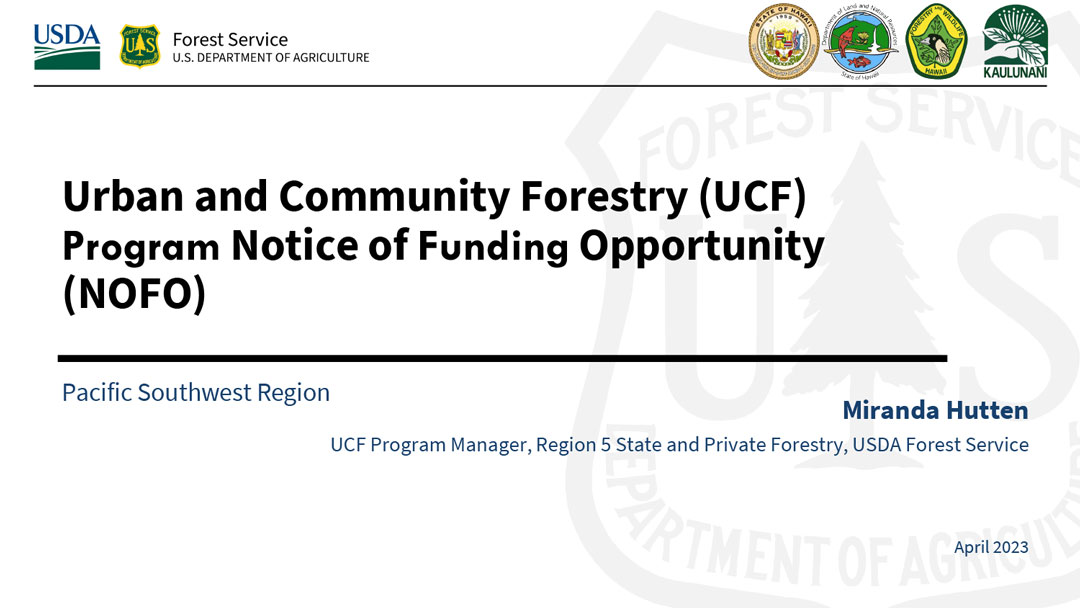If you missed our webinar, you can view the recording above.
The USDA Forest Service just released their Inflation Reduction Act Notice of Funding Opportunity (NOFO), allowing the following to begin applying for IRA funds: state and local governments, federally recognized Tribes and Tribal organizations, nonprofit organizations, and community-based organizations – among others. To help organizations prepare applications, we hosted a webinar with Miranda Hutten, the Urban & Community Forestry Program Manager from the Forest Service.
If you missed the webinar, you can watch it above or on YouTube. The video includes the presentation and the Q&A section.
The presentation covered essential information about who is eligible to apply, what could be covered for funding, information regarding match requirements, and much, much more.
View a list of relevant links from the webinar below.
RELEVANT LINKS FROM WEBINAR
All applicants must have active registration at sam.gov and maintain active registration throughout the life of the award. This is the government-wide web-based system that supports all contracts, grants, and the electronic payment system.
How to apply for federal Urban and Community Forestry grants:
- the Forest Service website
- www.grants.gov use the opportunity number USDA-FS-2023-UCF-IRA-01
For more information on funding to states and territories:
Inflation Reduction Act Funding Information:
Justice 40 Initiative:
For inquiries specific to the content of the NOFO requirements, contact the following shared inbox: [email protected]). Please limit questions to those regarding specific information contained in this NOFO (such as dates, page numbers, clarification of discrepancies, etc.). Questions related to eligibility or the merits of a specific proposal will not be addressed.
All applications for grants must be submitted by 11:59 pm Eastern Time on June 1, 2023.
Based on feedback from partners, the interpretation of the competitive sub-award section in the NOFO has changed. Please follow the directions below when you develop your application.
Pass-Through Funding (Sub-Awards)
Q: Are there primarily two types of proposals for the NOFO?
1) those in which an organization runs a competitive sub-award program to fund the work of other eligible entities, and
2) those in which an eligible entity wants to directly receive a grant for implementing an urban and community forestry project or program (other than competitive sub-awards) and will compete against the other similar proposals in the NOFO process
A: Yes.
Q: Does the section titled “Pass-Through Funding (Sub-Awards)” in the NOFO summary text and grant portal (see text below) only apply to those who are wishing to run a competitive sub-grant program (i.e., proposal category one in the previous question)?
A: Yes. The instructions under “Pass-Through Funding (Sub-Awards)” only apply to those organizations wishing to run a competitive sub-grant program.
From the application portal – Pass-Through Funding (Sub-Awards)
In response to stakeholder feedback and to alleviate the administrative burden on small, capacity-strained applicants, to expedite funding to communities in greatest need, and to increase opportunities to award high volumes of grants in condensed timeframes, applications from eligible entities with demonstrated ability to competitively pass-through (subaward) funding to community-based organizations and other partners serving disadvantaged communities are encouraged. A minimum of 80% of all funding to a pass-through entity must be competitively sub-awarded to community-based organizations, or other partners serving disadvantaged communities. Funding to Pass-Through Entities will be executed through a grant or cooperative agreement with substantial Forest Service involvement at the discretion of the Forest Service.
Q: If organizations want to partner on a project, do they each need to apply separately, or can they submit one proposal where one partner is the lead and receives the funds and contracts or sub-grants with the other organizations (proposal category two from the first question)?
A: One proposal may be submitted. The proposal should demonstrate true collaboration among partners; clearly describe each partner’s role, capability/expertise, and capacity; and include letters of support from partners. This proposal type does not require 80% of the grant to be competitively sub-awarded.
To download the presentation, click on the image above or here.

